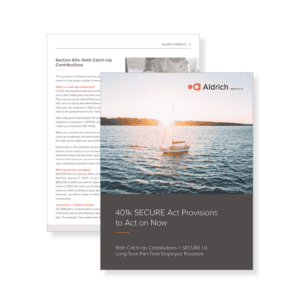The Next Evolution of Target Date Funds
One of the biggest challenges faced by 401(k) plan sponsors has been helping participants devise asset allocation strategies that result in successful retirement outcomes.
The mutual fund industry introduced target date funds (TDFs) in 1994 to help address this problem. TDFs make investing for retirement easier for many participants by allowing them to invest in a single fund based on their target retirement date, instead of having to devise their own asset allocation plan or hire an investment advisor to do this for them.
Target Date Funds Becoming More Popular
Over the past quarter-century, target date funds have grown more common as a mutual fund choice and default option in defined contribution plans. For example, about two-thirds of 401(k) plans now include TDFs, notes the Employee Benefit Research Institute (EBRI).
Not surprisingly, the volume of retirement assets held in target date funds continues to grow at a steady clip — from $1.11 trillion to $1.33 trillion between the end of 2015 and 2016, according to Sway Research. By 2020, it’s projected that up to 90 percent of all new 401(k) plan contributions will be allocated to TDFs.
Adding Alternative Assets to Target Date Funds
It appears that some noteworthy changes are occurring with TDFs as they near their 25th birthday. One of these is the inclusion of alternative asset classes in more TDFs. These include real estate, commodities, hedge funds and high-yield bonds.
By adding alternative assets to target date funds, fund managers enable participants to achieve even greater diversification. Alternatives do cost more, though, so the anticipated improvements to investment outcomes must be greater than the higher fees incurred by the fund.
There are other challenges involved when offering private alternative assets like real estate and hedge funds within TDFs, including the need for daily valuation and liquidity. It takes creativity to meet these challenges without watering down alternative investments so much that the strategy loses its effectiveness.
Passive is Popular
Passive strategies have increasingly become popular as the combination of a long bull market and a focus on fees has been the overarching narrative. The approach is not entirely as passive as most investors think it is, however. The allocation along the glide path, the decisions on what asset classes to include, and which underlying index fund is being used to represent these spaces are very active decisions.
Generating Retirement Income with Target Date Funds
The distribution phase of retirement planning is another area where change is coming to target date funds. If a participant takes a distribution from a target date fund, they could be selling both stocks and bonds indiscriminately in volatile markets. Providers have been exploring other solutions to meet distribution needs. For example, some TDFs are starting to offer the opportunity for participants to generate guaranteed income streams after they retire by investing a portion of the fund’s assets in an annuity payout.
But there are cost and operational challenges involved in doing so. Large six-figure balances invested in annuities often result in relatively small monthly income payouts so many participants remain hesitant to adopt this strategy. Plan sponsors are also reluctant to add this feature due to the added fiduciary responsibility.
Target Date Funds Customized to the Person
One drawback of off-the-shelf target date funds is that the sliding asset allocation models they use (which are referred to as the glide path) are pretty much one-size-fits-all, because they are solely based on age and the assumption that the person will retire at age 65 (which is very often not the case). To make the glide path more flexible and customizable, some TDF solutions are incorporating additional data beyond just age into asset allocations.
These solutions use information such as the participant’s marital status, historical contribution rates, current balance, customized targeted retirement date (if the person enters it), the availability of a defined benefit plan or other retirement assets in the creation of asset allocations.
One of the challenges with using these customized TDFs or managed accounts is getting participants to provide the additional information. Recordkeepers can provide some, but not all, of the data. In today’s environment, where high-profile data breaches like the one that occurred last year at Equifax are becoming more common, participants may be even less-inclined to provide additional demographic information to plan sponsors. Without this additional information, the asset allocation strategies may work against other strategies in a participant’s cumulative portfolio. Additionally, plan fiduciaries are required to evaluate and monitor these solutions in a comprehensive and prudent way. The proper way to assess these solutions is uncharted territory.
The Future of Target Date Funds
There’s little question that target date funds are evolving today and will continue to do so in the future. Increasing liquidity, lower costs and advancements in technology are making more options available. We continue to stay on the cutting edge of these advancements while making sure any change is prudent and in the best interest of participants.
Meet the Author
Heather has 23 years of experience providing guidance to 401(k) retirement plan committees and helping clients understand investments, compliance, fiduciary responsibility, and administration for corporate retirement plans. Her profound knowledge and collaborative approach empower her to deliver comprehensive solutions that prioritize the needs of our clients and the strategic growth of the firm, while considering…
Heather's EXPERTISE
- Certified Plan Fiduciary Advisor (CPFATM)
- Series 7 and Series 66 security exams
- Accredited Investment Fiduciary (AIF®)
- Corporate retirement plans

